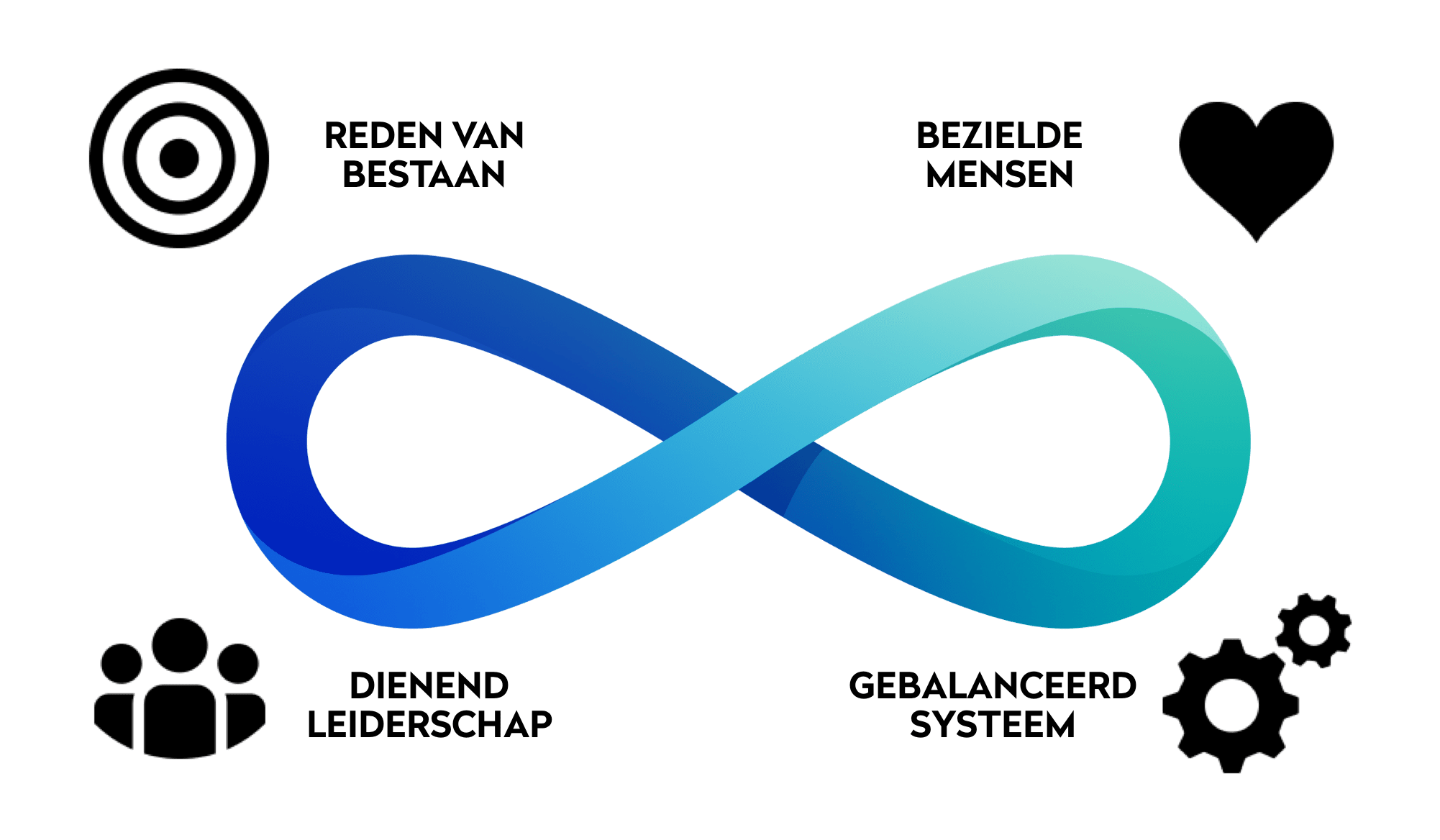WHITEPAPER – The spirited organisation
MANAGEMENT SUMMARY
Spirited organisations know what they want to bring to the world. That is why they are relevant. Now and in the future. Unfortunately, it is exactly this spirit that is lacking in many organisations. The focus is often on maximizing profit and short-term thinking. The negative effects of this focus are all over the news every day. The model of the spirited organisation provides clear guidance to counteract this process. The model places the focus on adding value as core purpose of the organisation and on trust as a basis for leadership. Furthermore, it has a strong emphasis on the connection between employees and on strategical agility as an organisational system. When companies becomes spirited, this adds value for people, organisation and society.

CONTENT
- REASON – What we see
- MODEL – Our approach
- MODEL – The 4 elements
- Purpose
- Spirited people
- Servant leadership
- Balanced system
- CONCLUSION – View on the future
- INSPIRATION – Reading tips
- THE CHANGE COLLECTIVE – About us
REASON – What we see
Spirited organisations know what they want to bring to the world. That is why they are relevant. Now and in the future. Unfortunately, it is exactly this spirit that is lacking in many organisations. The focus is often on maximizing profit and short-term thinking. The negative effects of this focus are all over the news every day.
Many organisations have drifted away from their core – adding value – and are therefore becoming more and more hollowed out. In an attempt to counteract this, organisations depend on numerous organisational emergency measures, that – because they are treating the symptoms instead of the actual cause – are ineffective in the long term. We also see that people can no longer identify with the vision of the organisation that they work for. And subsequently they can also no longer connect with each other. Because of this, a lot of productive energy is wasted.
Take, for example, a bank. The purpose of the bank lies in solving a collective action problem, namely: the unfair distribution of resources. The bank adds value to society by connecting people with too few resources, to people with too many. This process earns the bank money, making it a win-win-win model. However, by making profit a core goal, the bank has drifted away from its initial purpose. In practice this leads to excesses and to employees losing their connection with the company and each other. Subsequent interventions such as the introduction of policies and codes of conduct, will achieve very little. This symptomatic approach merely has the effect of slowly halting the operation and making everyone tired and wary of change.
We believe that organising in the 21st century needs to change. In order to remain relevant as an organisation in these rapidly changing times – and to be successful in the long-term – a fundamental reform is necessary. Both in thinking as well as in practice.
MODEL – Our approach
The rapid pace at which shifts in society take place, present organisations with big challenges. Strategical agility is a must, as is the ability to create value. This demands new ways of organising.
But genuinely changing the way you shape your organisation, is easier said than done. The challenges and processes that obstruct change, are often deeply rooted in the system and cannot be changed by symptomatic interventions or merely placing a sticking-plaster on the wound.
To set in motion a fundamental change, a holistic view is needed. How is the organisation structured and how is it managed? From which point of view are dilemma’s approached and how is contact with employees, clients and stakeholders established? Genuine change also requires looking in depth at both the business as the people side of the organisation. Besides shared goals, processes, structures and tasks, an organisation is made up of people. Because of this, emotions like fear but also individual egos and a general lack of trust, are frequently driving powers. Just like in the ‘real world’. The connection of the business and the people aspect, is what we call_Spirit and Strategy_.
In order to create a basis for our clients and our consultancy work, we have created a model that is made up of four core elements. These elements provide a clear framework for the needed changes within an organisation, to guarantee its success and relevance in the long term. The focus is on restoring the mission to add value as the core goal, on connection between employees and on strategic agility as an organisational system. These elements strengthen each other, and an organisation can only truly thrive when they are all in balance. This is our model for the spirited organisation.
MODEL – The 4 elements
 PURPOSE
PURPOSE
What is it
The purpose of an organisation represents why it does what it does. In other words, with which goal the organisation has been set up. Purpose is essentially nothing more than offering a solution for a collective action problem. In short, value must be added. In a spirited organisation we look at the value added on economic, ecological and social level.
One of the most important reasons for degradation that we come across in organisations, is the switching of priority between the goal (purpose) and the means (money). When asked, a lot of businesses would explain that they were founded with the purpose of making profit, but this can never be the true purpose. Profit – just as existing purely to exist – is not a purpose in itself, but results from adding value. By placing the focus on making profit, less attention is given to the actual goals of the organisation. Therefore that organisation will, however ironic, lose profit and capsize in the long run.
The effect
A clear purpose is therefore the driving power behind a spirited organisation. When it is apparent which value is being added, this provides the entire organisation with a destination and it is apparent what everyone can do to reach this destination.
The result of this is a clear focus on where the company is going. All activities that do not contribute to the purpose are not relevant. In this manner, all decisions can be based on the actual purpose of the organisation.
An example of this is an e-commerce company that wanted to determine their strategy for the coming five years. The process quickly ran into difficulties when pressure mounted from the stakeholders and Supervisory Board, and further internal disagreement. We decided to take them back to the origin of the company and presented them with the following question: Which value is being added by our existence? By making decisions about the desired developments the coming five years from that starting point, the internal disagreements were solved. Furthermore they were able to present a clear storyline to the Supervisory Board and other stakeholders about the chosen focus and the decisions made.
Where to start
Finding the purpose is in fact nothing more than discovering what is already there. Purpose is not about wishful thinking, but about the elementary underlying thread that is already present in an organisation. This thread can be identified by asking the following question: What would the world have to go without if your organisation ceases to exist today? In answering this question, don’t focus on things like clients being angry about their project being cancelled, but on which value would fall away. What can clients no longer do now?
What is needed to achieve this:
- Shared view of origin and passion
- Insight in the broader system
- Collective ambition
- Courage to make choices
- Dedication to remain true to the purpose
 SPIRITED PEOPLE
SPIRITED PEOPLE
What is it
Spirited people feel intrinsically connected to the organisation’s purpose and to each other. Because a spirited organisation strives to add value, this offers employees the opportunity to connect their personal life goals to that of the organisation. In this way they can truly connect to the group of colleagues they work with, making them likeminded peers. They are all working towards the same goal.
Spirited people are not radars in a machine. They are people with their own preferences, motives and styles of working. They have insight in the way they personally contribute to the whole and the influence their own actions have. These are people with a strongly developed reflective power, who don´t shy away from taking a critical look at themselves. This is directly palpable in their open communication; they speak their minds but at the same time aren’t afraid to receive feedback.
The effect
Because it is clear that ultimately everyone is pursuing the same goal, a connection is created on an existential level. This opens the willingness for people to try to understand and accept each other and creates the opportunity for people to show their vulnerability. In this way it is possible for all individuals to determine how they can contribute to the true purpose in their own roles. This insight provides grounds for a good collaboration (on both operational as well as emotional level), improving the quality of teams. By creating insight in one’s own actions and awareness of dynamics within the organisation, a healthy feedback culture emerges, in turn causing productivity to rise. The combination of a good collaboration and the feeling of ownership, will eventually cause flow to return to the organisation. This positive and productive energy will always result in delivering more value to the client.
We came across a good example of a spirited organisation at a fire department. When, during a regionalisation several fire departments were forced to merge into one big regional department, it was exactly this spiritedness that was used as the starting-point. By addressing the shared intrinsic connectedness, the resistance was considerably less than during mergers in regular organisations. Classic problems in collaboration were dealt with and resolved very quickly by the employees themselves, as a direct consequence of the strong feeling of ownership. The employees openly shared their needs and wanted to look to the future. The deep rooted wish to quickly get back to adding value - by helping people in need - motivated people even more.
Where to start
Creating spiritedness is really about all the people in an organisation entering into a connection with one another. When the purpose is clear, it is important that everyone translates this to their specific role. Open conversations about opportunities and issues in the collaboration must be held. Expectations of one another should be established. Furthermore it is essential that everyone feels free and safe to speak out to all layers of the organisation, and that their opinions are heard and action is taken.
What is needed to achieve this:
- Insight in influence of own actions
- Trust
- Opportunity for authenticity
- Appreciation
- Transparant communication
 SERVANT LEADERSHIP
SERVANT LEADERSHIP
What is it
Servant leadership is a term that in itself may discourage a few leaders, because it expects you to be able to step over your own shadow. It is based on the concept that leaders are there to serve the organisation and its people, and not vice versa.
It is of the utmost importance that leaders are spirited people themselves too, and that they carry the responsibility that they have been given by the organisation. They have the responsibility to redefine the purpose and adjust it when required. Furthermore, they guide the business in facing the most important organisational dilemma’s. And guiding is definitely the most appropriate word here, as the actual completion is done by the spirited people. Trusting their people is therefore the starting-point for servant leaders. They give employees space and enable them to add their individual value. All decisions are made with a view to facilitating the collective.
Effect
The result is optimal effectivity in the organisation, because on the one hand adequate guidelines are provided to realize the work, whilst on the other hand there is enough freedom granted for people to do that work according to their own insights. This provides people with the opportunity to learn, take their own initiative and to be innovative.
Because servant leaders give trust, they also gain trust. Because of this, the organisation is well equipped to quickly adjust course when necessary. Because people have learned that strategic decisions are made with the general interest in mind, they trust that their leaders will guide them in the right direction.
A good, albeit not obvious, example of this is the army. And more specifically the Special Forces. In these groups a strong culture of operational freedom has always been important. The classic culture of hierarchy doesn’t work for these teams, as they must be able to react flexibly to their circumstances and need space to innovate and learn in the moment. A great amount of time is therefore spent on leadership within these structures, whereby officers determine the guidelines, but anyone in the team is able to take the position of leader if necessary – if this is in the benefit of the team or mission. To achieve this, a great deal of trust is necessary. Trust in the guidelines set by the officers, and trust in the judgement and capability of the team members.
Where to start
There are two important elements that first need to be brought to light. Firstly, the most important strategic dilemma’s in the organisation, that leaders must make decisions about. Secondly, the division of tasks and responsibilities, with the aim to always appoint these as low down in the organisation as possible. In doing this, the need for growing trust is apparent.
What is needed to achieve this:
- Organising a culture of self-reflection
- Support as top priority for management
- Insight in organisational dilemma’s
- Setting aside personal interest
- Developing leadership
 BALANCED SYSTEM
BALANCED SYSTEM
What is it
The principle of a balanced system is that it is completely in support of realising the purpose. In more practical terms, this means that all processes and structures within the organisation support the people, and not vice versa. Because of this, everyone is able to contribute optimally.
On the one hand an optimal structure for performance must be designed. On the other hand, there must be enough room for employees to feel connected to the organisation, and for them to add their personal value. This balance should always be present. This differs from the classic lean thinking, because it means that elements that could be seen as waste, are now specifically cultivated as freedom to move for the system and its people.
Effect
The most important effect of a balanced system, is that it is perfectly apparent for everyone in the organisation which tasks they have in order to contribute to the whole. Within these tasks it is clear which responsibilities and authority to decide are present. This creates an uncomplicated and clear work structure that provides calm within the organisation.
Furthermore, every job is optimally supported by the processes and systems surrounding it, creating optimal effectivity. There is also an ongoing monitoring of processes to ensure these do not obstruct the job in hand. The organisational structure and processes should always facilitate the purpose. If this is the case, it creates the required agility, both on operational as well as tactical and strategic level.
A concrete example of this is a big pharmaceutical company that wanted to prepare itself to face the challenges of the rapidly changing market. The first step was to clearly determine the purpose and vision together with the leadership team. Subsequently the entire organisational structure was shaped to support this vision, including shifts in the Board. After that, the management was elaborately trained and drilled to lead the change. Once all these steps were put in place, the new processes and structures were implemented in close collaboration with the employees. In doing so the company ensured they optimised the entire organisation in one go, making it future proof. The culture programme that followed, had the main purpose of cultivating pro-activity, learning from mistakes and giving feedback. In doing so, the balance and agility were maintained, and the entire organisation remained engaged.
Where to start
The best and simplest way to get started on creating a balanced system, is to approach it as if you were building a new organisation. Starting point is the purpose and strategy - which should probably be available -, and from there outlining what your employees need in order to optimally contribute to this. Compare this desired situation to the existing organisation and you will be presented with a first outline of where there are problems that need to be solved.
What is needed to achieve this:
- Analysis of the organisational system
- New organisational design
- Clear design principles
- Organised direct feedback loops
- Discipline to embed new processes
CONCLUSION – View on the future
Why is all this important? What does it bring people, organisations and society if companies are more spirited? What makes it worthwhile to invest time and energy in this fundamental change?
We believe that bringing spiritedness to organisations adds value on both micro-, meso- and macro level. We believe that the movement of positive energy, interconnectedness and business success will spread exponentially.
In practice this means that on a micro-level, individuals will experience more happiness. They gain purpose from their daily work, are no longer seen merely as a ‘resource’ that has to be optimised, and get to work in a positive culture in which connection and trust are the starting-point. This attitude will effect all the interactions in their life, and the positive energy will therefore spread.
On a meso-level, organisations will improve their performance and become more successful. Leaders will govern a smoother functioning system, and therefore spend less time on escalation management. And as a consequence of the better results, there will be a much more positive and relaxed atmosphere in the organisation. There will also be more value added for clients and other stakeholders, who therefore will be prepared to enter into long-term partnerships, spreading the success throughout the value chain.
Eventually, on a macro-level, the entire standard of living in society will rise. This will increase the level of wealth for everyone, making a better and happier standard of life attainable for the majority. Because all organisations will be focused on their core purpose of adding value, and will have become better at doing so, a great deal of the collective action problems of our society will be solved for everyone.
Overall, the development of more spirited organisations can have a positive effect on the majority of people over a long period of time.
That is how we can change the world. One organisation at a time.
INSPIRATION – Reading tips
This is a selection of 15 titles that have inspired us and formed the basis for our model.

THE CHANGE COLLECTIVE - about us
The Change Collective is a consultancy firm which is focused on new ways of organising. We believe that we can change the world by supporting leaders in creating spirited organisations.
We are ambitious consultants with a clear vision on organisational design and expertise in the field of leadership development. We have an open and direct style of communicating, so we say what needs to be said. Our programmes are 100% tailored to organisations. We always take your specific culture and strategy as a starting point.
A spirited organisation is the result of an intensive process. This requires courage and a clear strategy. We help organisations (re)discover their purpose and support them in shaping themselves to achieve maximal impact.